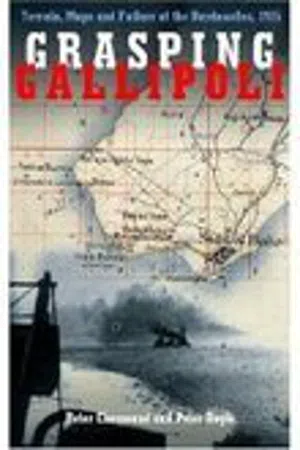History
Dardanelles Campaign
The Dardanelles Campaign, also known as the Gallipoli Campaign, was a World War I military operation in 1915. It aimed to secure a sea route to Russia and knock the Ottoman Empire out of the war. However, the campaign resulted in heavy casualties for the Allied forces and ultimately ended in failure, leading to the evacuation of troops.
Written by Perlego with AI-assistance
Related key terms
4 Key excerpts on "Dardanelles Campaign"
- eBook - ePub
Grasping Gallipoli
Terrain, Maps and Failure at the Dardanelles, 1915
- Peter Chasseaud, Peter Doyle(Authors)
- 2015(Publication Date)
- Spellmount(Publisher)
CHAPTER 2
Genesis of the Gallipoli Campaign
The Dardanelles, that strategic waterway connecting the Aegean Sea and Mediterranean with the Sea of Marmara and ultimately, connecting through the Bosphorus, the Black Sea, has been a point of interest to military minds for centuries. Constantinople, the modern city of Istanbul, sits astride the Bosphorus and guards the entrance to the Black Sea thereby controlling entry to the winter ports of Russia. Because of this and a myriad of other reasons, Constantinople, the seat of the Sublime Porte , the name commonly used for the Ottoman Court and the Turkish Government, has long been coveted, particularly by Greece and Russia.At the other end of the Marmara lies the Dardanelles, a narrow passageway between European and Asian Turkey, a tightly constrained waterway created by geological faulting over millennia. In European Turkey, the shores of the Dardanelles are guarded by the Gallipoli Peninsula, a narrow finger of land named after its principal settlement. Opposing this is the Asiatic Shore, the Aegean expression of the great Anatolian Peninsula, the greater part of modern Turkey, and the heart of the ailing Ottoman Empire in 1915. Fortified for centuries, the idea of squeezing a fleet of ships between the beetling brows of the shores of the Dardanelles has continually exercised the mind of the military of many nations, particularly so in the complex diplomacies of two centuries before the Gallipoli landings of 1915.It is not possible to examine the relationship between operational planning on the one hand, and geographical intelligence on the other, without taking account of the political decision-making process, and of the extent to which the military and naval authorities were admitted to this decision-making in wartime. It is therefore necessary to look at the prolonged period during which Britain’s strategic gaze, not to mention that of other European nations, was drawn to ‘The Sick Man of Europe’, and during which the consequent ‘Eastern Question’ was one of the dominant issues of political and public debate. Conflict with Russia over her approach towards India, or with Turkey over Egypt and the Suez Canal, inexorably raised the question of operations in the Dardanelles on several occasions, and on each of these occasions led to surveys, reconnaissances and intelligence-gathering initiatives which added to the data bank of available information. - eBook - ePub
Gallipoli & the Middle East 1914–1918
From the Dardanelles to Mesopotamia
- Edward J Erickson(Author)
- 0(Publication Date)
- Amber Books Ltd(Publisher)
The Ottoman coastal defences at the Dardanelles comprised forts containing 82 heavy guns. This photo shows a heavy coastal gun stationed at the Narrows. Eventually the Turks would augment these defences with an additional 230 artillery pieces including heavy howitzers. CHAPTER 2 The Dardanelles The relatively brief operations in the Dardanelles form one of the most famous episodes of the entire war. From the point of view of the Allies, the attempt to secure access to Constantinople and the Black Sea via the Dardanelles Straits and the Sea of Marmara was shown to be over ambitious and poorly planned, while the Ottoman forces proved themselves to be stubborn and courageous in their defence. O ne historian claims today that ‘there are more books written about Gallipoli in the English speaking world than on any other campaign in World War I’. This high level of interest almost certainly derives from the fact that the Gallipoli campaign had the most wide-ranging implications and possibilities of any single effort in that war, which in a sense gives it the greatest ‘What if…?’ appeal as well. The campaign was singularly unique, in that it was the only large-scale amphibious operation of the war and it involved land, sea and air forces. It was also a combined operation involving multi-national forces on land and sea. Moreover, it was fought over a landscape that was pockmarked with history and war; from the battlefield itself, it was even possible to see the ruins of Troy. As a result, today there are many levels of modern historical interest, among both professionals and amateurs, the focus of which ranges from political and diplomatic history down to the activities of individual soldiers in trenches - eBook - ePub
The Last Century of Sea Power, Volume 1
From Port Arthur to Chanak, 1894–1922
- H. P. Willmott(Author)
- 2009(Publication Date)
- Indiana University Press(Publisher)
The Dardanelles venture emerged after some two decades of unprecedented study of history within the Royal Navy, but much of that effort was effort wasted because of the inadequacy of its scholarship and the mendaciousness of the navy’s purpose. The baleful influence of such individuals as Sir Julian Corbett (1854–1922) and Richmond was critically important, specifically in seeking to explain British operational success and failure in terms of personality at the expense of any real examination of the problems that attended joint operations and by their espousal of various myths that surrounded civil-military relations with respect to certain specific episodes (and not just in 1739–1740). The Dardanelles initiative came after the navy had lost the critical “roles-and-mission” argument with the army but when the navy nevertheless remained committed to a maritime as opposed to a continental strategy. After the Committee of Imperial Defence meetings of July 1912 the navy still aspired to a major role in the Mediterranean in no small reason because of its own institutional requirements. The real truth of the situation was that British history is largely a story of trying to run the maritime and continental in tandem and as complements to one another, not as either/or. The point of present-day relevance, of course, is that the Dardanelles venture must be seen against a background of a decade of furious argument between the services, and a most deliberate manipulation of historical argument and peddling of self-justifying mythology by the navy in its attempt to secure its own perceived raison d’être.As it was, the Dardanelles operation serves notice of the truth of one Nelsonian dictum: only a fool attacks forts. There were forts on Gallipoli, but the real point is that the peninsula itself was a fortress, and the campaign showed the danger of attacking so powerfully invested a defensive position. With this fact comes another, that fleets are at their most vulnerable when operating in direct support of the army ashore. The most obvious danger is when armies are moving backward, in retreat, but perhaps even more dangerous is the position that is seldom recognized—when armies are not moving at all, witness the Guadalcanal campaign. And it is perhaps recalling that at Gallipoli there was no air problem with which to contend.In seeking to explain the Dardanelles operation in terms of present-day doctrine one would note four matters. The preliminary attacks—by the navy either alone or in conjunction with minor landing operations—were anticipatory, and most certainly had they been pushed through to a successful conclusion would have taken the British within the Turkish decision-making cycle. These attacks were also directed against weakness: the general unpreparedness of Turkey for war and specifically the unpreparedness of Turkish forces and positions on the Gallipoli peninsula in the period November 1914–March 1915 bordered upon the chronic, and were much more severe than could have been anticipated on the part of a major power. The fragmented operations of this period were the very opposite of what modern doctrine demands, and the fluid battle, characterized by devolved command, initiative, and the avoidance of synchronization and set-piece action, was perhaps observed though not exactly in the manner that was intended but on account of the breakdown of command and the pattern imposed by a hostile terrain. In reality, the British offensive at the Dardanelles was to founder for a number of self-evident and well known reasons that need no elaboration at this point. The fact remains that even if the plan of campaign had been faultless in concept and detail, if all the means needed to carry the operation through to success had been present and if everything had unfolded quite contrary to what von Moltke believed, there is no good reason to believe that the Allied effort would have been successful. - Allen L. Churchill, Francis Trevelyan Miller(Authors)
- 2016(Publication Date)
- Last Post Press(Publisher)
Halil Bey’s prediction of the reestablishment of communications with the Central Powers was not long in being fulfilled. Within two weeks the Germano-Austrian drive from the Danube had penetrated to Bulgarian territory opposite the Rumanian frontier, and within another fortnight it had linked up with the Bulgarian columns in the south operating against Nish. For all practical purposes Serbia was in their hands, and the powerful economic group heralded by Halil Bey was in the process of completion.There is no doubt that the forging of this strong link with Berlin was one of the main considerations in inducing the Allies to abandon the Dardanelles Campaign. There were two immensely important reasons why this should have radically changed conditions in the Gallipoli Peninsula.In the first place, there was the question of supplies. There are three ways in which modern wars on a big scale can be won: by direct military pressure, by financial pressure, or by economic stress. In the case of the Allies’ offensive against Turkey, after the first disappointment of the naval military operations, it was confidently predicted that economic stress would accomplish what military pressure had failed to do. It was known that Turkey had but meager means of making good the enormous expenditure of heavy-gun ammunition necessary in modern battles. Indeed, as early as the big naval attempt to force the Dardanelles, rumors were heard of a shortage of ammunition in the Turkish forts, and in this connection it is interesting to print a report that gained currency at the time of the abandonment of the Anzac and Suvla Bay bases.Had the allied fleet returned to its attack upon the Dardanelles batteries on the day following the great bombardment of March 19, 1915, the waterway to Constantinople would surely have been forced, in the opinion of several artillery officers of the defense works near Tchanak-Kalessi expressed to the Associated Press correspondent, who had just reached Vienna.One of the principal batteries, it appeared, had for three of its large caliber guns just four armor-piercing shells each when night ended the tremendous efforts of the British and French fleet.For the fourth gun five shells were left, making for the entire battery a total of seventeen projectiles of the sort which the aggressors had to fear. What this meant is best understood when it is considered that the battery in question was the one which had to be given the widest berth by the allied fleet.
Learn about this page
Index pages curate the most relevant extracts from our library of academic textbooks. They’ve been created using an in-house natural language model (NLM), each adding context and meaning to key research topics.



